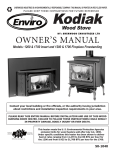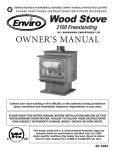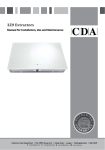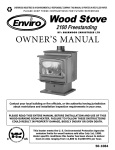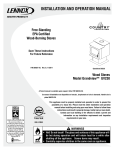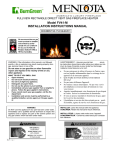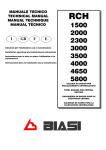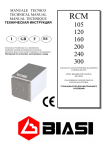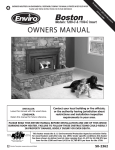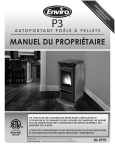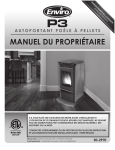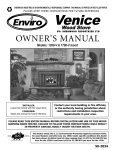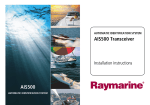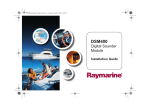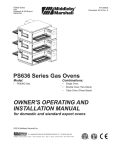Download Enviro 1200 Fireplace Insert Stove User Manual
Transcript
SHERWOOD INDUSTRIES IS AN ENVIRONMENTALLY RESPONSIBLE COMPANY. THIS MANUAL IS PRINTED ON RECYCLED PAPER. Kodiak PLEASE KEEP THESE INSTRUCTIONS FOR FUTURE REFERENCE Wood Stove BY: SHERWOOD INDUSTRIES LTD OWNER’S MANUAL Models: 1200 & 1700 Freestanding and 1200 & 1700 Fireplace Insert Contact your local building or fire officials, or the authority having jurisdiction about restrictions and installation inspection requirements in your area. PLEASE READ THIS ENTIRE MANUAL BEFORE INSTALLATION AND USE OF THIS WOOD BURNING ROOM HEATER. FAILURE TO FOLLOW THESE INSTRUCTIONS COULD RESULT IN PROPERTY DAMAGE, BODILY INJURY OR EVEN DEATH. Tested & Listed By C O-T L OMNI-Test Laboratories, Inc, Beaverton Oregon USA This heater meets the U. S. Environmental Protection Agencies emission limits for wood heaters sold after July 1st, 1988. Under specific conditions this heater has been shown to deliver heat at rates ranging from 11,479 to 34,196 BTU per hour for the 1200 and from 9,425 to 31,780 BTU per hour for the 1700. 50-1040 Table of Contents Safety Precautions.............................................................................................3 Operating Instructions........................................................................................4 Building Your Fire...................................................................................5 Air Control.............................................................................................8 How It Works.........................................................................................9 Specifications..................................................................................................10 1200 Specifications...............................................................................10 1700 Specifications...............................................................................11 Clearances To Combustibles - 1200 Insert...............................................12 Clearances To Combustibles - 1700 Insert...............................................12 Clearances To Combustibles - 1200 Freestanding....................................13 Clearances To Combustibles - 1700 Freestanding....................................14 Dimensions - 1200 Insert......................................................................15 Dimensions - 1700 Insert......................................................................15 Dimensions - 1200 Freestanding............................................................16 Dimensions - 1700 Freestanding............................................................17 Freestanding Side Dimensions For Fan Kit...............................................18 Installation......................................................................................................19 Removal From Pallet.............................................................................19 Pedestal Installation - Freestanding........................................................19 Legs And Ash Pan Installation - Freestanding..........................................20 Installation Of Heat-Efficiency Shield - Freestanding Flat Top....................20 Outside Air Kit......................................................................................21 Recommended Heights For Flue Pipe......................................................21 Chimney Installation Through Wall........................................................22 Installation of a Listed, Factory Built Chimney - Freestanding...................23 Masonry Fireplace Installation - Freestanding..........................................26 Mobile Home Installation - Freestanding.................................................26 Masonry Fireplace Installation - Insert....................................................28 Model 1200 Brick Placement..................................................................30 Model 1700 Brick Placement..................................................................31 Door Installation...................................................................................32 Ceramic Baffle Installation.....................................................................33 Fan Wiring Diagram..............................................................................33 Optional Fan Installation - Freestanding..................................................34 Fan Removal - Insert............................................................................34 Removal Of The Shrouds - Insert...........................................................35 Installation Of The Decorative Plates - Insert..........................................35 Installation Of The Surround Panel - Insert.............................................36 Parts List.........................................................................................................37 Parts Diagram - Freestanding...........................................................................39 Parts Diagram - Pedestals & Legs.....................................................................40 Parts Diagram - Fireplace Insert.......................................................................41 Warranty.........................................................................................................42 Installation Data Sheet.....................................................................................45 2 Safety Precautions FOR SAFE INSTALLATION AND OPERATION OF YOUR “ENVIRO” WOOD STOVE, PLEASE CAREFULLY READ THE FOLLOWING INFORMATION: ● Please read this entire manual before you install and use your new woodstove. Failure to follow instructions may result in property damage, bodily injury or even death. Be aware that local Codes and Regulations may override some items in this manual. Check with your local inspector. ● If this appliance is not properly installed, operated and maintained, a serious house fire could result. Do not use any makeshift materials during installation, maintenance, or replacement. ● Never place wood, paper, furniture, drapes or other combustible materials near the stove. Do not let children or pets touch it when it is hot. ● Operate only with the door and ash pan tightly closed and burn wood directly on the stove floor. Do not operate if the door glass is broken or a gasket is missing or damaged. Do not alter the combustion air control valves. Dangerous overfiring could occur which could ignite creosote in the chimney or cause a house fire. ● At least 12 inches2 (77.4 cm2) of fresh outside air should be admitted into the room or directly to the stove through a 4 inches (10.16 cm) diameter pipe. It would be dangerous to operate the stove with the combustion-air inlet closed. ● Do not burn coal or charcoal as there is danger of carbon monoxide being produced. Do not use chemical fluids to start or re-fresh the fire. Do not burn garbage or flammable fluids such as gasoline, grease, naphtha or engine oil. Never let the stove become hot enough to get any part red or glowing red. ● Burning wet, unseasoned wood could cause excessive creosote accumulation. When ignited, it could cause a chimney fire that could result in a serious house fire. ● Do not use grates, andirons or any other methods to support or raise the fire up off the hearth of the appliance. ● This appliance is tested to ULC-S627 Standard for Space Heaters for Use with Solid Fuel, ULC-S628 Standard for Fireplace Inserts, & UL 1482 Standard for Safety for Solid-Fuel Type Room Heaters. IMPORTANT: The following must be done to ensure proper operation. Failure to do so will cause extreme overheating and possible personal injury or property damage: • If an outside air supply has not been added to this appliance, please ensure that the 4” inch fresh air outlet on the back of the pedestal is removed. • Ensure that the ash dump grate and cover plate are installed over the ash dump hole. 3 Operating Instructions FIRST START When first installed, the chimney, firebricks and steel are cold and it usually takes several hours on a fairly high burn for them to become hot and dry enough for the stove to function well. The paint will smell a little for the first burn or two as it cures. You may wish to open a door or window to eliminate the smell. FANS: All models have been approved for operation with or without the optional fans supplied by the manufacturer. On medium or high burns, using a fan will increase the heat transfer slightly. Route the power supply cord along the floor behind the stove where it will remain cool. DISPOSAL OF ASHES: If you let the ashes accumulate two or three inches on the floor they tend to burn themselves up. Open the small trap door located on the floor of the unit. Push the ashes that have accumulated into the hole were the ashes would drop into the ash pan. Ensure that the trap door is closed properly before relighting the unit. When necessary, put the ashes in a metal container with a tightly fitting lid. Place the closed container on a non-combustible floor, well away from combustible materials. If the ashes are to be buried in soil or otherwise locally dispersed, keep them in a closed container until all cinders have cooled. If your model has an ash pan, be sure to latch the ash pan tightly when finished. Small amounts of cold wood ash can be used in the garden or compost. REPLACING THE GLASS: Never strike or slam the door, hit the glass or let burning wood rest against it. If the glass cracks when the fire is burning, do not open the door until the fire is out and do not operate the stove again until the glass has been replaced. If the glass is damaged in any way, a factory replacement is required (see “PARTS LIST”). To remove the door, open and lift. To replace the glass, remove the steel retaining clips and all loose glass. Replace only with Neoceram 5 mm glass 16.61” (422 mm) x 10.63” (270 mm) and wrap the edges with 0.125” (3.2 mm) x 0.5” (13 mm) self-adhesive fiberglass gasket. Wear gloves when handling damaged glass door assembly to prevent personal injury. When the glass door assembly is being transported, it must be wrapped in newsprint and tape and/or a strong plastic bag. The glass must be purchased from an ENVIRO dealer. No substitute materials are allowed. CLEANING THE PLATED SURFACES: Painted faces should be wiped with a damp cloth periodically. If a plated door has been purchased, it should be unpacked carefully to avoid getting anything on the surface of the finish, including cleaners, polish and finger prints. It is important to note that fingerprints and other marks can leave a permanent stain on plated finishes. To avoid this, give the face a quick wipe with denatured alcohol on a soft cloth BEFORE lighting the fireplace. Never clean the door when it is hot. Do not use other cleaners as they may leave a residue, which can become permanently etched into the surface. FIRE EXTINGUISHER AND SMOKE DETECTION: All homes with a solid fuel burning stove should have at least one fire extinguisher in a central location known to all in the household and a smoke detection devise in the room containing the stove. If it sounds the alarm, correct the cause but do not deactivate. You may choose to relocate the smoke detection devise within the room; DO NOT REMOVE THE SMOKE DETECTOR FROM THE ROOM. 4 Operating Instructions CREOSOTE - ITS FORMATION AND REMOVAL: When wood is burned slowly, it may produce tar and other vapors that, combined with moisture, form creosote. These vapors condense in the relatively cooler chimney flue of a slow burning fire and, if ignited, make an extremely hot fire. Therefore, the smoke pipe and chimney should be inspected biweekly during the heating season to determine if a build-up has occurred. If creosote has accumulated it should be removed to reduce the risk of a chimney fire. CHIMNEY OR RUN AWAY FIRE: 1. Call local fire department (or dial 911) 2. Close the draft fully 3. Examine the flue pipes, chimney, attic, and roof of the house, to see if any part has become hot enough to catch fire. If necessary, spray with fire extinguisher or water from the garden hose. 4. Do not operate the stove again until you are certain the chimney and its lining have not been damaged. MAINTENANCE: At the end of each heating season clean the chimney and the smoke pipe. If soot has accumulated above the top baffle bricks, remove, clean, and then replace them. If the secondary air tube is badly eroded, replace it. Replace worn door gaskets and broken bricks as needed. FAILURE TO INSPECT AND CLEAN YOUR CHIMNEY SYSTEM REGULARLY CAN RESULT IN A CHIMNEY FIRE, WHICH COULD DAMAGE THE CHIMNEY OR CAUSE A HOUSE FIRE. BUILDING YOUR FIRE: Proper operation of your stove will help to ensure safe, efficient heating. Please take a few moments to review these simple operating procedures. 1. Fuel Selection: This stove is designed to burn natural wood only. Higher efficiencies and lower emissions generally result when burning air-dried seasoned hardwoods, as compared to softwoods or to green or freshly cut hardwoods. DO NOT BURN the following: treated wood, coal, garbage, solvents, colored papers, or trash. Burning these may result in the release of toxic fumes and may poison or render the catalytic ineffective. Burning coal, cardboard, or loose paper can produce soot, or large flakes of char or fly ash that can coat the combustor, causing smoke spillage into the room, and rendering the combustor ineffective. 2. Building/Maintaining a Fire: a) Open the primary air slide by pulling it all the way to the right. b) Place a base of crumpled uncolored newspaper in the bottom of the stove. Lay pieces of kindling on top of the newspaper and light it. CAUTION: “Never use gasoline, gasoline-type lantern fuel, kerosene, charcoal lighter fluid, or similar liquids to start or “freshen up” a fire in this heater. Keep all such liquids well away from heater while it is in use. c) As the kindling begins to burn, add several larger pieces of wood until the fire is burning well. At this point, regular size logs may be added. NOTE: Until the fire is burning well, leave the air controls fully open. 5 Operating Instructions d) Regulate the heat output of the stove by adjusting the air controls to allow a larger fire and vice versa. A short period of experimentation with the control settings will allow you to regulate the heat output to keep your home comfortable. Do not use a grate or elevate the fire. Build wood fire on the stove firebox hearth floor. 3. Refueling the Stove: Use a long pair of gloves (barbecue gloves) when feeding the fire because these stoves burn at the front. They are clean and efficient but they are also very hot and gloves are useful. Keep a small steel shovel and whisk nearby for moving a log or lifting a fallen ember and for keeping the hearth clean. a) Before attempting to add fuel to the stove, OPEN the damper control fully by pulling it all the way out. This allows the chimney to carry away the additional smoke, which occurs when the door is open. b) DO NOT OVERLOAD THE STOVE. Normally, three or four logs will provide heat for several hours. Never operate this stove where portions glow red hot. c) DO NOT OVERFIRE. If the heater or chimney connector glows, you are overfiring. d) CAUTION: DO NOT PLACE FUEL WITHIN SPACE HEATER INSTALLATION CLEARANCES OR WITHIN THE SPACE REQUIRED FOR CHARGING AND ASH REMOVAL. 4. For Maximum Efficiency: When the stove is hot, load it fully to the top of the door opening and burn at medium low settings. When the fuel is mostly consumed, leaving a bed of red coals, repeat the process. Maximum heat for minimum fuel occurs when the stove top temperature is between 250 °F (120 °C) and 550 °F (290 °C). The most likely causes of dirty glass are: not enough fuel to get the stove thoroughly hot, burning green or wet wood, closing the draft until there is insufficient air for complete combustion, or a weak chimney draw. Indeed, the cleanness of the glass is a good indicator of the stove operating efficiently. Helpful Hints Worth Repeating 1. Helpful advice on the correct way to start your fire. a) You will need small pieces of dry wood, called kindling, and paper. Use only newspaper or paper that has not been coated or had other materials glued or applied to it. Never use coated (typically advertising flyers) or coloured paper. b) Always open the door of the wood stove slowly to prevent suction and drawing smoke into the room. c) Crumple several pieces of paper and place them in the center of the firebox and directly onto the firebricks of the wood stove. Never use a grate to elevate the fire. d) Place small pieces of dry wood (kindling) over the paper in a “teepee” manner. This allows for good air circulation, which is critical for good combustion. e) Light the crumpled paper in 2 or 3 locations. Note: It is important to heat the air in the stovepipe for draft to start. f) Fully open the air controls of the wood stove and close the door until it is slightly open, allowing for much needed air to be introduced into the firebox. Never leave the door fully open, as sparks from the kindling may fly out of the stove, causing damage or injury. As the fire begins to burn the kindling, some additional kindling may be needed to sustain the fire. DO NOT add more paper after the fire has started. g) Once the kindling has started to burn, add some smaller pieces of seasoned, dry firewood. Note: Adding large pieces at the early stages will only serve to smother the fire. Continue adding small pieces of seasoned dry firewood, keeping the door slightly open until each piece starts to ignite. Remember 6 Operating Instructions to always open the door slowly between placing wood into the fire. h) Once the wood has started to ignite and the smoke has reduced, close the wood stove door fully. The reduction of smoke is a good indication that the draft in the chimney has started and good combustion is now possible. Larger pieces of seasoned, dry firewood can now be added when there is sufficient space in the firebox. Adjust the air control setting to desired setting. Note: The lower the air control setting, the longer the burn time of your firewood. 2. What type of wood is best to use as firewood? Both hardwood and softwood burn well in this stove. Both woods contain about 8,000 BTU/lb (18,570 KJ/Kg), but hardwood is generally denser, will weigh more per cord, and burns a little slower and longer. Cutting firewood so that it will fit horizontally, front to back, makes it easier loading and less likely for the fuel to roll on the glass. Except for a cold start, there is no need to crisis-cross the logs. Ideal length for the logs used in the 1200 would be about 16“ (381 mm) but it can burn pieces up to 18” long logs. Ideal length for the logs used in the 1700 would be about 18“ (381 mm) but it can burn pieces up to 20” long logs. Burn only dry, seasoned wood. It produces more heat and less soot or creosote. Freshly cut wood has about 50% moisture. A 10 pound (4.5 Kg) log contains 5 pounds (2.3 Kg) of water. To season firewood, split and stack it so that air can get to all parts of the wood. Burn beach wood only if its salt content has been washed away in a season of rain and then the wood dried. To prevent smoke spillage when refueling, open the door slowly. 3. What does dry, seasoned wood mean? Wood that has been dried for a period of one year in a well-ventilated and sheltered area would be considered dry, seasoned wood. Wood from slow-growing trees is generally considered better than wood from fast-growing trees. To season firewood, split and stack it so that air can get to all parts of the wood. 4. Will following the above-listed steps for starting a fire mean perfect results every time? The quick answer is ‘ most of the time’. There are many variables that may affect your success when starting a fire. Most of those variables and how to deal with them will be learned through experience. Your ability to start a good fire will significantly increase with time and patience. Some of the reasons for poor stove performance will be covered in the next section of these instructions. 5. Why can’t I get the fire lit? Damp or wet wood and poor drafts are the main reasons for poor results in starting a fire. Always use dry, seasoned wood for your fire. Even wood dried for two years will be difficult to ignite if it has become wet. 6. Is it normal for soot to cover the glass at the beginning of a fire? Your stove has been built with an air-wash system that will help keep the glass clear when the firebox has reached a good operating temperature and has a good draft. Normally a hot stove will keep the glass clean, but if you must clean the glass, use a soft cloth with no abrasive and clean only when cold. Cold firebox temperature and poor draft cause sooting of the glass. Once the firebox temperature and the draft increase, the soot will burn off. 7. What is draft? Draft is the ability of the chimney to exhaust or draw smoke produced during the normal combustion process. Too much draft may cause excessive temperatures in the appliance and may damage the appliance. Inadequate draft may cause backpuffing or “plugging” of the chimney. There is a certain amount of draft that is required to allow for your stove to function at its’ highest efficiency. A water column gauge can be used to reference this amount. 7 Operating Instructions 8. What can cause a poor draft? The most common factors for poor draft are: a) Air supply b) Environmental conditions c) Cold chimney temperature d) Poor chimney installation and maintenance e) Atmospheric pressure a) Air supply – Inside the home, normal household appliances such as clothes dryers and forced-air furnaces compete for air, resulting in air starvation to the fire. This creates a condition in the house known as negative pressure. When a house experiences negative pressure, the combustion gases can be drawn from the chimney and into the house. This condition is commonly referred to as downdrafting. Increased amounts of insulation, vinyl windows, extra caulking in various places and door seals can all keep heat in but may also make a home too airtight. An easy way to stop negative pressure in a home is to crack a window in the room containing the stove. b) Environmental Conditions - High trees, low-lying house location such as in a valley, tall buildings or structures surrounding your house and windy conditions can cause poor draft or down-drafting. c) Cold Chimney Temperature - Avoid cold chimney temperatures by burning a hot fire for the first fifteen to forty minutes, being careful not to over-fire the stove. If any part of the chimney or parts of the stove start to glow, you are over-firing the stove. Where possible, install a temperature gauge on the chimney so temperature drops can be seen. d) Chimney Installation and Maintenance - Avoid using too many elbows or long horizontal runs. Too short a chimney can cause difficult start-up, dirty glass, back smoking when door is open, and even reduced heat output. Too tall a chimney may prompt excessive draft, which can result in very short burn times and excessive heat output. If in doubt, contact a chimney expert and/or chimney manufacturer for help. Clean chimney, rain caps and especially the spark arrestor regularly, to prevent creosote buildup, which will significantly reduce chimney draw and possibly a chimney fire. Note: These instructions are intended as an aid and do not supercede any local, provincial or state requirements. Check with officials or authorities having jurisdiction in your area. AIR CONTROL: The air wash and pilot air (control the amount of air to the fire) are controlled by the rod located on the right side of the unit. To increase your air, pull the rod out and to decrease, push the rod in. All the units have a secondary air that flows through the tubes at the top of the firebox, just below the baffles. Pull this control all the way out when first starting the stove. Once the fire has been established you may adjust this control to set the burn rate of the fire. If this damper is closed at first start-up, the fire will burn very slowly and could soot the appliance. When shutting down the stove, fully open the air control. This allows the chimney temperatures to remain as high as possible for as long as possible. Cold chimney temperatures create creosote. 8 Increase air - pull rod out Decrease air - push rod in Figure 1: Air Control Rod. Operating Instructions HOW IT WORKS: Smoke 1/2" Ceramic baffle; reflects heat down to burn up smoke. Primary air; window airwash. Secondary air tubes; creates a secondary burn on the particles in the smoke. Pilot air. Dry seasoned wood Slider plate; used for air flow control. Intake air. Intake air. Figure 2: 1200 Air Flow Path. Smoke 1/2" Ceramic baffle; reflects heat down to burn up smoke. Primary air; window airwash. Secondary air tubes; creates a secondary burn on the particles in the smoke. Pilot air. Dry seasoned wood Slider plate; used for air flow control. Intake air. Intake air. Figure 3: 1700 Air Flow Path. 9 Specifications 1200 SPECIFICATIONS: Table 1: 1200 General Information. Model 1200 Freestanding Flat Top Width x Depth Step Top 25” x 22 7/16” (635 mm x 570 mm) Height with pedestal or legs 28 1⁄4” (718mm) 31 1⁄4” (794 mm) Height of body 18 1⁄4” (464 mm) 21 1⁄4” (540 mm) Fire box size 1200 Insert 273⁄4” x 211⁄2” (705 mm x 546 mm) 191/16” (484 mm) 16.1” x 18.25” x 11.15” (409 mm x 464 mm x 283 mm) (depth x width x height) 1.85 feet3 (0.0526 meter3) Capacity 800 - 1,500 feet2 (74.3 - 139.4 meter2) * Approximate heating area **E.P.A. output rating 11,479 to 34,196 BTU/hour (3,361 to 10,013 watt) *Duration on low burn 6 -10 hours Weight with packaging E.P.A. Emissions 335 lb (151.95 Kg) 375 lb (170.10 Kg) 335 lb (151.95 Kg) 3.3 grams/hour (0.116 oz/hour) Surround Panels Standard (width x height) Oversized (width x height) 10 461⁄8” x 28” (1171 mm x 711 mm) 461⁄8” x 331⁄8” (1171 mm x 843 mm) Specifications 1700 SPECIFICATIONS: Table 2: 1700 General Information. Model 1700 Freestanding Flat Top Width x Depth 25” x 26 Step Top 15/16” (635 mm x 684 mm) Height with pedestal or legs 28 1⁄4” (718mm) 31 1⁄4” (794 mm) Height of body 18 1⁄4” (464 mm) 21 1⁄4” (540 mm) Fire box size (depth x width x height) 273⁄4” x 26” (705 mm x 660 mm) 191/16” (484 mm) 20.65” x 18.25” x 11.95” (525 mm x 464 mm x 304 mm) 2.5 feet3 (0.0708 meter3) Capacity * Approximate heating area 1700 Insert 1,000 - 2,200 feet2 (92.9 - 205.4 meter2) **E.P.A. output rating 9,425 to 31,780 BTU/hour (2,760 to 9,306 watt) *Duration on low burn 8 - 12 hours Weight with packaging E.P.A. Emissions 390 lb (176.90 Kg) 420 lb (190.51 Kg) 390 lb (176.90 Kg) 4.48 grams/hour (0.158 oz/hour) Surround Panels Standard (width x height) Oversized (width x height) 461⁄8” x 28” (1171 mm x 711 mm) 461⁄8” x 331⁄8” (1171 mm x 843 mm) 11 Specifications CLEARANCES TO COMBUSTIBLES - 1200 INSERT: 10” (254 mm) A Minimum clearance to an unshielded side wall B Minimum clearance to an unshielded 8” (203 mm) mantle C Minimum top facing (protruding 3⁄4” [19 mm]) clearance 171⁄2” (445 mm) D Minimum side facing (protruding 3⁄4” [19 mm]) clearance 1” (25 mm) E † From front of unit to edge of floor protection USA 16” (406 mm) CND 18” (450 mm) F † From side/back of unit to edge of floor protection USA 6” (152 mm) CND 8” (200 mm) 21” (533 mm) �������� ���� Table 3: 1200 Insert Clearance to Combustibles. � � � � � � † FLOOR PROTECTION: If unit is raised 0” - 2” (0mm-51mm); 1” (25mm) non-combustible material with k value = 0.84 or equivalent. If unit is raised 2” - 8” (51mm-203mm); 1⁄2” (13mm) non-combustible material with k value = 0.84 or equivalent. If unit is raised greater than 8” (203 mm) or more; any non-combustible material can be used. Table 4: 1200 Insert Minimum Fireplace Size. Masonry Zero Clearance Minimum Depth 131⁄2” (343mm) 14” (279mm) Minimum Width at back of fireplace 223⁄8” (568mm) 23” (584mm) Minimum Width at front of fireplace 27” (686mm) 271⁄4” (692mm) Minimum Width at front of fireplace to include shroud 333⁄4” (857mm) 34” (864mm) Minimum Height 191⁄4” (489mm) 20” (508mm) CLEARANCES TO COMBUSTIBLES - 1700 INSERT: A Minimum clearance to an unshielded side wall 10” (254 mm) B Minimum clearance to an unshielded 8” (203 mm) mantle 24” (610 mm) C Minimum top facing (protruding 3⁄4” [19 mm]) clearance 191⁄2” (495 mm) D Minimum side facing (protruding 3⁄4” [19 mm]) clearance 1” (25 mm) E † From front of unit to edge of floor protection USA 16” (406 mm) CND 18” (450 mm) F † From side of unit to edge of floor protection USA 6” (152 mm) CND 8” (200 mm) �������� ���� Table 5: 1700 Insert Clearance to Combustibles. � � � � † FLOOR PROTECTION: If unit is raised 0” - 2” (0mm-51mm); 1” (25mm) non-combustible material with k value = 0.84 or equivalent. If unit is raised 2” - 8” (51mm-203mm); 1⁄2” (13mm) non-combustible material with k value = 0.84 or equivalent. If unit is raised greater than 8” (203 mm) or more; any non-combustible material can be used. Table 6: 1700 Insert Minimum Fireplace Size. Masonry Minimum Depth 12 � Zero Clearance 18” (457mm) 181⁄2” (470mm) Minimum Width at back of fireplace 223⁄8” (568mm) 23” (584mm) Minimum Width at front of fireplace 27” (686mm) 271⁄4” (692mm) Minimum Width at front of fireplace to include shroud 333⁄4” (857mm) 34” (864mm) Minimum Height 191⁄4” (489mm) 20” (508mm) � Specifications CLEARANCES TO COMBUSTIBLES - 1200 FREESTANDING: MAINTAIN THESE MINIMUM CLEARANCES TO UNSHIELDED COMBUSTIBLES* �������� ���� � � ����� � � � ����� � ������ ���� ���� � ������ ������ ���� ���� � � � �� �� � ���� ���� � �������� ���� ���� ���� � � � J � � ����� I ������ Table 7: 1200 Freestanding Clearance to Combustibles. Single Wall Pipe Double Wall Pipe** Double Wall Pipe with Heat Shield (Flat top model only) Top vent out back wall with min. 48” (1220 mm) vertical rise; double wall A From side wall to side of unit 13” (330 mm) 13” (330 mm) 13” (330 mm) 14” (356 mm) B From rear wall to back of unit 11” (279 mm) 10” (254 mm) 8” (203 mm) 12” (305 mm) C From adjacent wall to corner of unit 9” (229 mm) 8” (203 mm) 61⁄2” (165 mm) D From side wall to collar 22” (559 mm) 22” (559 mm) 22” (559 mm) 23” (584 mm) E From rear wall to collar 14” (356 mm) 13” (330 mm) 11” (279 mm) 15” (381 mm) F From adjacent wall to collar 19” (483 mm) 18” (457 mm) 161⁄2” (419 mm) G † From front of unit to edge of hearth pad USA 16” (406 mm) CND 18” (450 mm) USA 16” (406 mm) CND 18” (450 mm) USA 16” (406 mm) CND 18” (450 mm) USA 16” (406 mm) CND 18” (450 mm) H † From side/back of unit to edge of hearth pad USA 6” (152 mm) CND 8” (200 mm) USA 6” (152 mm) CND 8” (200 mm) USA 6” (152 mm) CND 8” (200 mm) USA 6” (152 mm) CND 8” (200 mm) Alcove (48” [1220 mm] Deep) I Total Width 55” (1397 mm) J Total Height 78” (1981 mm) K Top of stove to ceiling 49” (1245 mm) L Side wall to stove 15” (381 mm) M Side wall to pipe 24” (610 mm) N Back wall to unit 12” (305 mm) O Back wall to pipe 15” (381 mm) CAUTION: An uninsulated smoke pipe must not pass through an attic, roof space, closet or similar concealed space, or through a floor, ceiling, wall, or partition, or any combustible construction. † FLOOR PROTECTION: If a stove is installed on a combustible floor, it must have a pedestal attached and be on a NON-COMBUSTIBLE hearth pad * ALL CLEARANCES CAN BE REDUCED WITH SHIELDING ACCEPTABLE TO THE LOCAL AUTHORITY. **DOUBLE WALL: IN CANADA: Any ULC-S629 listed chimney system with the accompanying listed double wall vent connector. IN U.S.A.: Any UL 103 HT listed chimney system with the accompanying listed double wall vent connector. 13 Specifications CLEARANCES TO COMBUSTIBLES - 1700 FREESTANDING: MAINTAIN THESE MINIMUM CLEARANCES TO UNSHIELDED COMBUSTIBLES* �������� ���� � � ����� � � � � ������ ���� ���� � ����� � � ������ ������ ���� ���� � �� �� � ���� ���� � �������� ���� ���� ���� � � � J � � ����� I ������ Figure 8: 1700 Freestanding Clearance to Combustibles Single Wall Pipe Double Wall Pipe** Double Wall Pipe with Heat Shield (Flat top model only) Top vent out back wall with min. 48” (1220 mm) vertical rise; double wall A From side wall to side of unit 20” (508 mm) 13” (330 mm) 13” (330 mm) 11” (279 mm) B From rear wall to back of unit 12” (305 mm) 10” (254 mm) 7” (178 mm) 13” (330 mm) C From adjacent wall to corner of unit 10” (254 mm) 81⁄2” (216 mm) 6” (152 mm) D From side wall to collar 29” (737 mm) 22” (559 mm) 22” (559 mm) 20” (508 mm) E From rear wall to collar 15” (381 mm) 13” (330 mm) 10” (254 mm) 16” (406 mm) F From adjacent wall to collar 20” (508 mm) 181⁄2” (470 mm) 16” (406 mm) G † From front of unit to edge of hearth pad USA 16” (406 mm) CND 18” (450 mm) USA 16” (406 mm) CND 18” (450 mm) USA 16” (406 mm) CND 18” (450 mm) USA 16” (406 mm) CND 18” (450 mm) H † From side/back of unit to edge of hearth pad USA 6” (152 mm) CND 8” (200 mm) USA 6” (152 mm) CND 8” (200 mm) USA 6” (152 mm) CND 8” (200 mm) USA 6” (152 mm) CND 8” (200 mm) Alcove (48” Deep) I Total Width 51” (1295 mm) J Total Height 72” (1829 mm) K Top of stove to ceiling 44” (1118 mm) L Side wall to stove 13” (330 mm) M Side wall to pipe 22” (559 mm) N Back wall to unit 8” (203 mm) O Back wall to pipe 11” (279 mm) CAUTION: An uninsulated smoke pipe must not pass through an attic, roof space, closet or similar concealed space, or through a floor, ceiling, wall, or partition, or any combustible construction. † FLOOR PROTECTION: If a stove is installed on a combustible floor, it must have a pedestal attached and be on a NON-COMBUSTIBLE hearth pad * ALL CLEARANCES CAN BE REDUCED WITH SHIELDING ACCEPTABLE TO THE LOCAL AUTHORITY. **DOUBLE WALL: IN CANADA: Any ULC-S629 listed chimney system with the accompanying listed double wall vent connector. IN U.S.A.: Any UL 103 HT listed chimney system with the accompanying listed double wall vent connector. 14 Specifications DIMENSIONS - 1200 INSERT: 461/8" (1171mm) 337/8" (860mm) 273/4" (705mm) 205/16" (516mm) Min. 131/4" (337mm) Max. 1415/16" (380mm) 5" (127mm) 161/2" (419mm) 2011/16" (525mm) Regular Surround 2715/16" (709mm) Oversized Surround 333/16" (709mm) 191/8" (486mm) 183/8" (467mm) 191/16" (484mm) 19" (482mm) 227/8" (580mm) 3/16" (5mm) Figure 4: 1200 Insert Dimensions. DIMENSIONS - 1700 INSERT: 461/8" (1171mm) 337/8" (860mm) 273/4" (705mm) 2413/16" (630mm) Min. 173/4" (452mm) Max. 197/16" (495mm) 5" (127mm) 21" (533mm) 2011/16" (525mm) Regular Surround 2715/16" (709mm) Oversized Surround 333/16" (709mm) 191/8" (486mm) 191/16" (484mm) 183/8" (467mm) 231/2" (596mm) 273/8" (695mm) 3/16" (5mm) Figure 5: 1700 Insert Dimensions. 15 Specifications DIMENSIONS - 1200 FREESTANDING: 22 7/16" 25" (570mm) 5 15/16" (635mm) 6 1/16" 16 1/2" (151mm) (153mm) (419mm) 30 1/4" 9 15/16" (769mm) (252mm) 15 13/16" (402mm) 29 15/16" (760mm) 28 1/4" 20" (508mm) 3 (718mm) 7/8" (98mm) 10" (254mm) Legs same height 14 3/4" 24 3/8" (375mm) 26 (619mm) 3/8" (670mm) Figure 6: 1200 Freestanding Flat Top Dimensions. 22 7/16" 13 (570mm) 7/16" 25" (341mm) (635mm) 5 15/16" 6 1/16" (151mm) (153mm) 9 15/16" (252mm) 32 3/4" 15 13/16" (402mm) (831mm) 31 1/4" (793mm) 10" (254mm) Pedestal same height 25 3/16" 18 3/8" (640mm) (467mm) Figure 7: 1200 Freestanding Step Top Dimensions. 16 Specifications DIMENSIONS - 1700 FREESTANDING: 25" 26 (635mm) 15/16" 19 3/8" (684mm) 5 15/16" (492mm) 21" (151mm) 6 1/16" (534mm) (153mm) 15 7/8" 9 15/16" (403mm) (252mm) 30 1/4" (769mm) 28 1/4" (718mm) 10" (254mm) Pedestal same height 23 1/16" (586mm) 24 1/2" 25 15/16" 3 7/8" (622mm) (659mm) (98mm) Figure 8: 1700 Freestanding Flat Top Dimensions. 26 15/16" (684mm) 16" 5 15/16" (151mm) 25" (635mm) (406mm) 6 1/16" (153mm) 32 11/16" (831mm) 9 15/16" (252mm) 15 7/8" (403mm) 31 1/4" (794mm) 10" (254mm) Legs same height 16 3/4" (426mm) 26 3/8" (670mm) 24 3/8" (619mm) Figure 9: 1700 Freestanding Step Top Dimensions. 17 Specifications FREESTANDING SIDE DIMENSIONS FOR FAN KIT: �� ������� � ���� ������� � ���� ������ �� ���� ������� Figure 10: 1200 Freestanding with Fan Kit Dimensions. �� ���� ��� � ���� ���� ��� �� ���� ���� ��� � ����� ���� ��� Figure 11: 1700 Freestanding with Fan Kit Dimensions. 18 Installation Please read and understand these instructions before installing pedestal or ash pan and leg option. Failure to follow these instructions carefully could cause personal injury or property damage. All screws are pre-installed on the base of the unit. REMOVAL FROM PALLET: • Remove the bricks from the unit before starting. • Remove the two (2) carriage bolts (shown in Figure 13) that secure the unit to the pallet from inside the firebox. Figure 12: Rivet. Note: After the pedestal or legs and ash pan have been installed but before the bricks are installed, rivets (Figure 12) must be placed in the two (2) holes (shown in Figure 13) in the firebox that carriage bolts came out of. This is done to make unit burn more efficiently. The shoulder rivets are found in the manual bag. Figure 13: Bolts to remove. PEDESTAL INSTALLATION - FREESTANDING: • Place the unit on the pallet on its back. • Slide the pedestal assembly over the bolts located on the base of the unit using the keyholed slots provided. • Tighten all four (4) bolts ensuring the pedestal is properly aligned to the edges of the unit. • Ensure that the gasket material is properly sealed before continuing. • Stand the unit on the pedestal and set the unit in the location ready for installation. • If fresh air supply is being supplied from the bottom of the unit please install the cover plate supplied to the rear of the pedestal covering the 4 inch (10 cm) hole. Note: In seismically active areas, it is recommended that your unit is secured to the floor by using the bolt-down holes inside the pedestal. Figure 14: Installing Pedestal. 19 Installation LEGS AND ASH PAN INSTALLATION - FREESTANDING: • Place the unit on the pallet on its back. • Attach pedestal spacer to bottom of the unit, using the supplied screws. • Attach the air channel box to the front of the pedestal spacer using two (2) T-20 screws. • Slide the ash pan assembly over the bolts, using the key-holed slots provided, and tighten all four (4) bolts. • Carefully remove the cast iron legs from the packaging and secure each leg with two (2) bolts provided. Figure 15: Installing Legs and Ash Pan Assembly. • Secure all four (4) legs, push the leg towards the center of the stove and align the legs with the outer edges of the firebox. • Stand the unit on the legs and set the unit in the location ready for installation. INSTALLATION OF HEAT-EFFICIENCY SHIELD - FREESTANDING FLAT TOP: The heat-efficiency shield is installed to lower the clearances to combustibles on the flat top freestanding model. ������� ��������� ���� ������ 1. The unit must be in position for the installation and with the venting ready to be assembled. 2. Loosen the two (2) top screws on the back of the unit using a 5/16” socket. 3. Place the heat-efficiency shield on top of unit. 4. Slide chimney connector through the heat-efficiency shield and over the flue. ���� ������ ������ 5. Lift the heat-efficiency shield and screw the chimney connector to the flue. 6. Slide the heat-efficiency shield down and hook the slot at the back of the shield, around the loosened screws at the back of the unit. 7. Tighten the two (2) screws at the back. Figure 16: Installing Heat Shield. 20 Installation OUTSIDE AIR KIT: It is manditory to use outside air for installations in mobile homes. ���� �� �������� A 4” (10.2 cm) fresh air adaptor kit is available. This adaptor can be installed either on the back pedestal or through the floor under the pedestal. The cover plate must be installed on the unit if your stove is located in a mobile home or if using outside air from the bottom. Place the 1⁄4” mesh screen between the fresh air adaptor and the body of the pedestal (as shown to right). NOTE: Fresh air connection to the unit must be a non-combustible pipe, Figure 17: Fresh Air Adaptor example: 4” (10.2 cm) single wall aluminum flex pipe. onto the Back of the Pedestal. NOTE: Remove the cover plate on the rear of the pedestal if room air is to be used for combustion air. RECOMMENDED HEIGHTS FOR FLUE PIPE: The minimum flue pipe height at sea level is 12 feet (3.7 m) straight up from top of the unit. For every 1000 feet (305 m) above sea level, 4% must be added to the overall height. Use Tables 7, 8, and 9 to calculate the required vertical rise required. Elevation above sea level feet Table 9: Recommended Height for Flue Pipe. Table 10: Distance to add to overall vertical height. Minimum recommended flue pipe height for # of elbows (Note: No more than 2 offsets (4 elbows) can be used. 2x45°=1x90° Part used feet meters 45° elbow 1.0 0.3 90° elbow 2.0 0.6 “T” 3.0 0.9 1 foot (0.3m) of horizontal run 2.0 0.6 Distance to add 0 2 x 15° 4 x 15° 2 x 30° 4 x 30° 2 x 45° 4 x 45° 0-1000 12.0 12.7 13.3 13.3 14.7 14.0 16.0 1000-2000 12.5 13.2 13.8 13.8 15.3 14.6 16.6 2000-3000 13.0 13.7 14.4 14.4 15.9 15.1 17.3 3000-4000 13.4 14.2 14.9 14.9 16.5 15.7 17.9 4000-5000 13.9 14.7 15.4 15.4 17.1 16.2 18.6 5000-6000 14.4 15.2 16.0 16.0 17.6 16.8 19.2 6000-7000 14.9 15.7 16.5 16.5 18.2 17.4 19.8 7000-8000 15.4 16.3 17.0 17.0 18.8 17.9 20.5 8000-9000 15.8 16.8 17.6 17.6 19.4 18.5 21.1 9000-10000 16.3 17.3 18.1 18.1 20.0 19.0 21.8 sea level with 2 x 30° elbows 13.3 ft (4.1 m) meters 0 2 x 15° 4 x 15° 2 x 30° 4 x 30° 2 x 45° 4 x 45° one “T” 3.0 ft (0.9 m) 0-305 3.7 3.9 4.1 4.1 4.5 4.3 4.9 305-610 3.8 4.0 4.2 4.2 4.6 4.4 5.1 11⁄2 ft (0.6 m) horizontal run 3.0 ft (0.9 m) 610-915 4.0 4.2 4.4 4.4 4.8 4.6 5.3 Total 1 19.3 ft (5.9 m) 915-1220 4.1 4.3 4.6 4.6 5.0 4.8 5.5 1220-1525 4.2 4.5 4.7 4.7 5.2 4.9 5.7 13.9 ft (4.2 m) 1525-1830 4.4 4.6 4.9 4.9 5.4 5.1 5.9 4000-5000 ft (1220-1525 m) above sea level 1830-2135 4.5 4.8 5.0 5.0 5.5 5.3 6.0 one “T” 3.0 ft (0.9 m) 2135-2440 4.7 4.9 5.2 5.2 5.7 5.5 6.2 2440-2745 4.8 5.1 5.4 5.4 5.9 5.6 6.4 2 ft (0.6 m) horizontal run 4.0 ft (1.2 m) 2745-3050 5.0 5.3 5.5 5.5 6.1 5.8 6.6 Total 2 20.9 ft (6.3 m) Table 11: Examples of calculating overall vertical height required. Height 21 Installation CHIMNEY INSTALLATION THROUGH WALL: Here are four (4) methods of combustible wall chimney connector pass-throughs. Information was provided from NFPA 211. Minimum chimney clearance to brick and combustibles 2 inches (50.8 mm) } Chimney Flue Minimum clearance 12 inches (304.8 mm) of brick Chimney connector Fire clay liner } Minimum 12 inches (304.8 mm) to combustibles Masonry chimney Figure 18: Chimney Through Wall - Method A. Minimum chimney clearance from masonry to sheet steel supports and combustibles 2 inches (50.8 mm) Factory-built chimney length } Non-soluble retractory cement Chimney length flush with inside of flue Chimney connector Use chimney manufacturer’s parts to attach connector securely Chimney flue Air space 9 inches (228.6 mm) minimum Minimum clearance 9 inches (228.6 mm) } Solid-insulated, listed factory-built chimney length Masonry chimney Sheet steel supports Method A. 12” (304.8 mm) Clearance to Combustible Wall Member: Using a minimum thickness 3.5” (89 mm) brick and a 5⁄8” (15.9 mm) minimum wall thickness clay liner, construct a wall pass-through. The clay liner must conform to ASTM C315 (Standard Specification for Clay Fire Linings) or its equivalent. Keep a minimum of 12” (305 mm) of brick masonry between the clay liner and wall combustibles. The clay liner shall run from the brick masonry outer surface to the inner surface of the chimney flue liner but not past the inner surface. Firmly grout or cement the clay liner in place to the chimney flue liner. Method B. 9” (229 mm) Clearance to Combustible Wall Member: Using a 6” (152 mm) inside diameter, factory-built Solid-Pak chimney section with insulation of 1” (25.4 mm) or more, build a wall pass-through with a minimum 9” (229 mm) air space between the outer wall of the chimney length and wall combustibles. Use sheet metal supports, fastened securely to wall surfaces on all sides, to maintain the 9” (229 mm) air space. When fastening supports to chimney length, do not penetrate the chimney liner (the inside wall of the Solid-Pak chimney). The inner end of the Solid-Pak chimney section shall be flush with the inside of the masonry chimney flue and sealed with a non-water soluble refractory cement. Use this cement to also seal to the brick masonry penetration. Figure 19: Chimney Through Wall - Method B. Minimum chimney clearance to sheet steel supports and combustibles 2 inches (50.8 mm) Two air channels each 1 inch (25.4 mm) } Chimney connector Minimum 6 inches (152.4 mm) glass fiber insulation } Two ventilated air channels each 1 inch (25.4 mm). Construction of sheet steel Chimney flue } Masonry chimney Sheet steel supportrs Method C. 6” (152.4 mm) Clearance to Combustible Wall Member: Starting with a minimum 24 gauge (.024” [0.6 mm]) 6” (152.4 mm) metal chimney connector and a minimum 24 gauge ventilated wall thimble which has two air channels of 1” (25.4 mm) each, construct a wall pass-through. There shall be a minimum 6” (152.4 mm) separation area containing fiberglass insulation, from the outer surface of the wall thimble to wall combustibles. Support the wall thimble and cover its opening with a 24 gauge minimum sheet metal support. Maintain the 6” (152.4 mm) space. There should also be a support sized to fit and hold the metal chimney connector. See that the supports are fastened securely to wall surfaces on all sides. Make sure fasteners used to secure the metal chimney connector do not penetrate chimney flue liner. Figure 20: Chimney Through Wall - Method C. Figure 21: Chimney Through Wall - Method D. Method D. 2” (50.8 mm) Clearance to Combustible Wall Member: Start with a solid-pak listed factory-built chimney section at least 12” (304 mm) long, with insulation of 1” (25.4 mm) or more, and an inside diameter of 8” (2” [51 mm] larger than the 6” [152.4 mm] chimney connector). Use this as a pass-through for a minimum 24 gauge single-wall steel chimney connector. Keep solid-pak section concentric with and spaced 1” (25.4 mm) off the chimney connector by way of sheet metal support plates at both ends of chimney section. Cover opening, and support chimney section on both sides, with 24 gauge minimum sheet metal supports. See that the supports are fastened securely to wall surfaces on all sides. Make sure fasteners are used to secure chimney flue liner. NOTES: 1. Connectors to a masonry chimney, excepting method B, shall extend in one continuous section through the wall pass-through system and the chimney wall, to but not past the inner flue liner face. 2. A chimney connector shall not pass through an attic or roof space, closet or similar concealed space, or a floor, or ceiling. 22 Installation INSTALLATION OF A LISTED, FACTORY BUILT CHIMNEY - FREESTANDING: This is a generic set of instructions; always follow the chimney manufacturer’s instructions explicitly. Also refer to “RECOMMENDED HEIGHTS FOR FLUE PIPE”. 1. 2. 3. 4. 5. 6. 7. 8. 9. Set floor protector and stove in location in accordance with the “CLEARANCES TO COMBUSTIBLES - 1200 FREESTANDING” or “CLEARANCES TO COMBUSTIBLES 1700 FREESTANDING”. 2 ft (0.6 m) Minimum Roof Mark the position for the ceiling hole by Ridge suspending a plumb bob from the ceiling over 3 ft (0.9 m) the exact center of your stove flue and mark Minimum Within10 ft (3 m) a spot on the ceiling to indicate the center of the chimney. Move this location, if necessary, to avoid floor joists, ceiling rafters, electrical wiring and plumbing while still maintaining required Figure 22: Roof Clearances. clearances. If floor joists or ceiling rafters must Rain cap/ be cut they must be made structurally sound Spark arrestor cap again. Install chimney according to chimney Storm Collar manufacturers instructions. A chimney connector cannot pass through an attic or roof Roof flashing Roof space, closet or similar concealed space, or a floor, ceiling, wall or partition of combustible construction. In Canada, if passage through a Attic Insulated chimney radiation shield wall or partition of combustible construction is desired, the installation shall conform to CAN/CSA-B365 Installation Code for SolidRadiation shield Fuel Burning Appliances and Equipment and Ceiling Ceiling support NFPA 211 Standard for Chimneys, Fireplaces, Minimum air space in Vents, and Solid Fuel-Burning Appliances. accordance with Mark the hole for the outside air kit. chimney manufacturer. Move the stove out of the way. Chimney connector Cut a pilot hole in the ceiling. Cut a hole for the ceiling penetration components and frame in the sides of the hole in both the ceiling and roof. Check, and Woodstove follow chimney manufacturer’s instructions Optional for all of these steps. fan Install the support box and chimney through the roof. Install the slip section for the Pedestal chimney connector. Hearthpad Slip the roof flashing over the chimney and secure to the roof, being careful to keep the pipe centered in the opening. To meet the Floor air connection code, the chimney must extend above the roof Outside through wall or floor penetration at least 3 feet (91.4 cm), and in any area within 10 feet (304.8 cm) of the roof Figure 23: Standard Vertical Installation. 23 Installation ridge, the chimney must be 2 Rain cap/ Spark arrestor cap feet (60.9 cm) above the ridge. Refer to Figure 22. Storm Collar Roof radiation Note: Increasing the chimney Roof flashing shield (if required) height above the roof may Roof help your unit to draft better. Insulated chimney This greater draft can decrease problems such as difficult start-ups, smoke coming out Minimum when door is open, and dirty Ceiling Minimum air space 18" (475 mm) in accordance with glass. You may initially try chimney manufacturer. the minimum required height and if problems do arise, add Insulated corner additional height later. 10. Slide the roof flashing over your Wall support chimney and seal the flashing Chimney connector to the roof with a roofing Chase compound. Secure the roof (optional) Optional flashing to your roof with nails Woodstove fan or screws. 11. Place the storm collar over the flashing and seal the joints with Pedestal Hearthpad silicone caulking. 12. Fasten the rain cap / spark arrestor cap to the top of your chimney. Floor Outside air connection through wall or floor 13. Place the stove back into position. Figure 24: Standard Horizontal Installation. 14. Install the chimney connector pipe with the lower (crimped) edge of the pipe inside the flue collar. Any creosote formed will then run back down into the stove. All connections must be tight and secured with three sheet metal screws equally spaced. Double wall pipe is recommended over single wall. 15. Also install an outside air flex pipe to the stove. IMPORTANT: When a metal prefabricated chimney is used, the manufacturer’s installation instructions must be followed. You must also purchase and install the ceiling support package or wall pass-through and “T” section package, firestops (where needed), insulation shield, roof flashing, chimney cap, etc. Maintain proper clearance to the structure as recommended by the manufacturer. The chimney must be the required height above the roof or other obstructions for safety and proper draft operation. Note: If you are using a horizontal connector (refer to Figure 24), the chimney connector should be as high as possible while still maintaining the 18” (475 mm) minimum distance from the horizontal connector to the ceiling. 24 Installation MASONRY CHIMNEY INSTALLATION - FREESTANDING: DO NOT CONNECT THIS UNIT TO A CHIMNEY FLUE SERVING ANOTHER APPLIANCE. A non-combustible floor protector is required under all freestanding units; refer to “CLEARANCES TO COMBUSTIBLES - 1200 FREESTANDING” or “CLEARANCES TO COMBUSTIBLES - 1700 FREESTANDING”. When venting into a masonry chimney, the floor protector must be installed directly below the chimney vent and 2” (50.8 mm) on either side of the chimney vent. Vent the stove into a clean, lined, approved masonry chimney in good condition, conforming to local building codes and meeting the minimum standards of the National Fire Protection Association (NFPA). Make sure there are no cracks, loose mortar or other signs of deterioration and blockage. Have the chimney cleaned before the stove is installed and operated, or vent with a listed 6” (150 mm) factorybuilt chimney suitable for use with solid fuels and conforming to ULC-S629 Standard for 650°C factoryBuilt Chimneys in CANADA or UL 103 HT Factory-Built Chimneys for Residential Type and Building Heating Appliances in the U.S.A. Connect the stove to this chimney with a short and straight 6” (150 mm), 24 gauge or heavier, single-wall black or blued steel smoke pipe. Connection to all masonry chimneys must be a metal or masonry thimble cemented in place. All smoke pipes must slope upwards, all connections must be tight and secured with three sheet metal screws equally spaced. The smoke pipe length should not exceed 40% of the chimney height above the stove. When connecting the stove through a combustible wall to a masonry chimney, additional steps are required. Consult the chimney connector manufacturer and refer to Figure 26. Termination cap / kit All chimneys in Canada must be fully lined with a 6" (150 mm) stainless steel liner from the chimney connector to the top of the chimney. Chimney thimble; non-combustible (cement or metal) and must be cemented in place. Single or listed double wall chimney connector. Minimum clearance single wall 10” (254 mm) double wall 8” (203 mm) (double check with pipe manufacturer) Wall thimble in combustible wall Rigid pipe Rigid tee Connector pipe Woodstove Access door for cleaning Optional fan. Pedestal Hearth pad. Outside air connection through wall or floor. Floor. Figure 25: Installation into a masonry chimney. Hearth pad 1” (25 mm) air gap Floor Figure 26: Installation into chimney through a combustible wall. 25 Installation MASONRY FIREPLACE INSTALLATION - FREESTANDING: Unless you are experienced, we recommend installation by your dealer or a professional installer. Many venting manufacturers have listed kits available to connect a stove to a masonry fireplace. Always follow the vent manufacturer’s installation instructions. The existing damper may have to be removed to allow installation. Rain Cap Chimney Support and Clamp Steel Plate or Flashing Rigid Stainless Steel Liner Listed Liner Stove pipe must end higher than liner Damper Removed or Fastened Open Flexible Stainless Steel Section Stainless Steel Connector Pipe Clean-out tee Clean-out cover Masonry Fireplace Floor Protection Combustible Floor Figure 27: Freestanding Installation into existing fireplace. MOBILE HOME INSTALLATION - FREESTANDING: SPECIAL REQUIREMENTS: Pedestal models 1200 and 1700 are approved for mobile homes. All freestanding installation requirements in “Installation Of A Listed, Factory Built Chimney”, must comply with all local codes that may apply, and the following must be met: VENTING: In Canada: Any ULC-S629 listed chimney system with the accompanying double-wall vent connector. In U.S.A. Any UL-103-HT listed chimney system with the accompanying double-wall vent connector. Do not connect a listed chimney of one manufacture with a listed double wall connector from another manufacture. 26 Installation These connectors must be installed in accordance with the manufacturer’s instructions. Use only specified components. The chimney and pipe must extend at least 10 feet (2.4 m) above the stove and 3 feet (0.9 m) above the highest point of the roof. Install a rain cap with spark arrestor at the top that will not impede the smoke exhaust. The chimney must be supported at the ceiling or roof so that its weight will not sit on the stove. Seal with silicone to maintain vapor barrier at the chimney and outside air penetrations. Spark arrestor cap Roof flashing At least 3 feet (914 mm) Roof Insulated chimney Radiation Shield Ceiling Ceiling support CAUTION: THE STRUCTURAL INTEGRITY OF THE MOBILE HOME FLOOR, WALL, AND CEILING/ROOF MUST BE MAINTAINED. OUTSIDE AIR : Connection from the stoves air intake to the outside is mandatory, (MOBILE HOMES ONLY) either through a hole in the wall not higher than the stoves bottom or through a hole in the floor beneath the pedestal, using the fresh air adaptor provided. If the air intake is through the floor, the hole in the pedestal back must be closed with the sheet metal cover provided. Avoid cutting any floor joists, wall studs, electrical wiring or plumbing. Seal around the outside air pipe with insulation to prevent drafts. Also install a 1⁄4” mesh rodent or pest screen in the end of fresh-air pipe. Fresh-air connection must be of a non-combustible material, example: 4” (10.16 cm) flexible aluminum single wall pipe. Double wall pipe Woodstove Optional fan Pedestal Hearthpad Outside air connection through wall or floor Floor Bolt stove to floor Fresh air could also be supplied from a vented Figure 28: Freestanding installation into mobile home. crawlspace. The pedestal must be firmly bolted to the floor using two (2) 1⁄4” bolts. Be sure to replace any insulation or panels removed when fastening the bottom nuts. If room air starvation occurs because the air intake is blocked with ice, leaves etc. or because the stove door was left open, or due to a strong exhaust fan operating, dangerous fumes could be sucked into the room. IN SOME AREAS IT MAY BE REQUIRED TO ELECTRICALLY GROUND THE STOVE TO THE STEEL CHASSIS OF THE MOBILE HOME. When this unit is installed in a Mobile Home it must be grounded to the steel chassis or connected to a grounding rod. Manufactured (Mobile) home installation must be in accordance with the Manufactured Home Construction and Safety Standard, UL 307B, Title 24 CFR, Part 3280 and/or The Standard for Manufactured Home Installations, ANSI A225.1/NFPA 501A. WARNING: DO NOT INSTALL IN A MOBILE HOME SLEEPING ROOM. 27 Installation MASONRY FIREPLACE INSTALLATION - INSERT: Unless you are experienced, we recommend installation by your dealer or a professional installer. Rain Cap Steel Plate or Flashing Flexible or Rigid 6" Stainless Steel Liner Mantel Install only in a masonry fireplace at least 25” (635 mm) wide, 22” (560 mm) high and 14” (356 mm) deep with a good-condition chimney at least 15 ft (4.6 m) high, both of which have been constructed in accordance with the building code. Be sure the fireplace and chimney are clean and sound without any cracks or loose mortar. Do not remove any bricks or mortar from the fireplace. Damper Removed or Fastened Open Face Plate If there is a combustible floor in front of the masonry fireplace, the fireplace insert must be 8” (203 mm) above the combustible floor, and floor protection must be provided 18” (457 mm) in front of the fireplace insert and 8” (203 mm) to each side of the unit. Sheet Metal Screws Fastening Collar to Stainless Steel Liner 1. Remove any fireplace damper or fasten in a permanent open position. Top Facing 18" (457 mm) Floor 8" Protection (203 mm) Masonry Fireplace It is recommended that you install the decorative plates (if purchased) into the shrouds before installing the unit. Refer to “INSTALLATION OF PODS AND DECORATIVE PLATES INSERT”. Combustible Floor 2. (IN CANADA) The stove is vented with a 6” stainless steel liner that goes directly to the top of the chimney and is covered with a rain cap. The chimney top is sealed with a flashing or steel plate that supports the weight of the chimney liner. The installation must conform to the liner’s manufacturer’s instructions. Figure 29: Insert Installation into existing fireplace with hearth. This fireplace must be installed with a continuous liner of 6” diameter (CANADA ONLY) extending from the fireplace insert to the top of the chimney. The chimney liner must conform to the class 3 requirements of ULC-S635 Standard for Lining Systems for Existing Masonry or FactoryBuilt Chimneys and Vents, or ULC-S640 Standard for Lining Systems for New Masonry Chimneys. (IN U.S.A.)The appliance when installed, must follow local building codes, in the absence of local building codes, with the current NFPA 211 Standard for Chimneys, Fireplaces, Vents, and Solid Fuel-Burning Appliances. 28 18" (457 mm) Floor Protection Masonry Fireplace 8" (203 mm) Combustible Floor Figure 30: Insert Installation into existing fireplace without hearth. Installation The flue collar is removable for installations into fireplaces with low openings. a) Remove the first two (2) front secondary air tube and ceramic baffles, if installed (see CERAMIC BAFFLE INSTALLATION). Flue plate clamp Hook/bolt Nut b) Unscrew the nut on top of the inside of the firebox, using a 9/16” wrench or socket (see Figure 31). The flue plate clamp will slide off the hook/clamp. c) Pull the hook/bolt and the removable flue collar off the top of the unit. Figure 31: Attaching removable flue. d) Attach the flue collar to the venting pipe using sheet metal screws. e) Push the unit into place while trying to keep the collar attached to venting close to the opening on the top of the unit. f) Using the hook/bolt, grab the flue collar by the rod through the center and pull it into place (see Figure 32). g) Slide the flue plate clamp over the end of the hook/bolt and screw the nut back on to the hook/bolt. h) Re-install ceramic baffles and the first two (2) front secondary air tube (see CERAMIC BAFFLE INSTALLATION). 3. There are two (2) leveling legs (shown in Figure 33), one on each side, at the back of the unit. Adjust the legs using a 9/16” wrench to ensure the unit is stable. Figure 32: Attaching removable flue. 4. Screw or nail the metal plate provided by the manufacturer to the inside of the fireplace. METAL TAG: “THIS FIREPLACE HAS BEEN ALTERED TO ACCOMMODATE A FIREPLACE INSERT AND SHOULD BE INSPECTED BY A QUALIFIED PERSON PRIOR TO THE RE-USE AS A CONVENTIONAL FIREPLACE.” Figure 33: Leveling leg. 29 Installation MODEL 1200 BRICK PLACEMENT: COMPLETE THE STOVE AND SMOKE PIPE INSTALLATION BEFORE PLACING THESE BRICKS. �� ��� � � � � �� � �� � � �� � �� ���� �� �� ���� � Figure 34: Brick Placement for 1200 shown with Secondary Air Channel and Tubes. 1. Place the three (3) full size bricks along each side of the firebox and one (1) full size brick on either side of the back of the firebox. 2. To place the floor bricks, lay the two (2) partial bricks along the back of the floor. Then on the left, lay two (2) full size bricks and on the right, lay a full size brick in the center and the half brick in the front (for the ash dump). The spaces between the bricks will soon fill with ashes. When replacing bricks, use only pumas type fire bricks. TOTAL BRICKS: 11 - Full size bricks 9” long x 4.5” wide x 1.25” thick (22.9 cm long x 11.4 cm wide x 3.2 cm thick) 2 - Partial bricks 9” long x 3” wide x 1.25” thick (22.9 cm long x 7.6 cm wide 3.2 cm thick) 1 - Half brick 4.5 “ long x 4.5” wide x 1.25” thick (11.43 cm long x 11.43 cm wide x 3.175 cm thick) 30 Installation MODEL 1700 BRICK PLACEMENT: COMPLETE THE STOVE AND SMOKE PIPE INSTALLATION BEFORE PLACING THESE BRICKS. � � ���� ������ ��� �� �� � � � � �� ���� �� ��� Figure 35: Brick Placement for 1700 shown with Secondary Air Channel and Tubes. 1. Place the four (4) full size bricks along each side of the firebox and one (1) full size brick on either side of the back of the firebox. 2. To place the floor bricks, lay the two (2) partial bricks along the back of the floor. Then on the left, lay three (3) full size bricks and on the right, lay two (2) full size bricks in the center and the half brick in the front (for the ash dump). The spaces between the bricks will soon fill with ashes. When replacing bricks, use only pumas type fire bricks. TOTAL BRICKS: 15 - Full size bricks 9” long x 4.5” wide x 1.25” thick (22.9 cm long x 11.4 cm wide x 3.2 cm thick) 2 - Partial bricks 9” long x 3” wide x 1.25” thick (22.9 cm long x 7.6 cm wide 3.2 cm thick) 1 - Half brick 4.5 “ long x 4.5” wide x 1.25” thick (11.43 cm long x 11.43 cm wide x 3.175 cm thick) 31 Installation DOOR INSTALLATION: Please inspect all components for damage. If damage has occurred, please contact the courier company, dealer, or distributor and have components repaired or replaced before installation. Remove the door from the packaging. Inspect the door assembly for damage. 1. Install door handle as shown in Figure 36. Nut Cast Latch Washer (x2) Spring Washer Furel Handle Figure 36: Installation Door Handle Hardware. 2. Place the door assembly on the two (2) hinge pins mounted on the body of the unit. Refer to Figure 37. Figure 37: Installation Door onto Unit. 3. Open and close the door, applying pressure down, to ensure the door assembly is properly seated on the hinges. Refer to Figure 38. 4. Please clean all fingerprints off of all plated surfaces, with denatured alcohol on a soft cloth, before firing the unit each time. Fingerprints, etc., can become permanently etched into the plating if not removed before operating the stove. Close the door assembly and turn the door handle downwards until door is tight. Thread slider damper handle onto slider damper control on the side of the unit. Figure 38: Closing Door. DO NOT USE DOOR IF GLASS IS BROKEN. 32 Installation CERAMIC BAFFLE INSTALLATION: 1. Remove the front secondary air tube by placing a screwdriver (any style except flat head) into one of the air holes and tapping it with a hammer/mallet to the left. Step 1 is only required on the insert models. 2. Slide the right ceramic baffle in over the secondary air tubes at the top of the firebox. The tab must be on the top and pointing towards the center and the smooth side is to face down. Right Ceramic Baffle Left Ceramic Baffle 3. Hook the outside edge of the baffle over the top of the secondary air chamber. This will make room to for the installation of the left ceramic baffle. 4. Slide the left ceramic baffle in over the secondary air tubes. The tab must be on the bottom and pointing towards the center and the smooth side is to face down. 5. Pull the baffles together in the middle so the right tab rests on top of the left tab. Ensure the baffles are flush with the back and both Figure 39: Installation of Ceramic Baffle. sides of the firebox. FAN WIRING DIAGRAM: This appliance, when installed, must be electrically connected and grounded in accordance with local codes or in the absence of local codes, with the current CSA C22.1 CANADIAN ELECTRICAL CODE. Part 1, SAFETY STANDARDS FOR ELECTRICAL INSTALLATIONS, or THE NATIONAL ELECTRICAL CODE ANSI / NFPA 70 in the USA. CAUTION Label all wires prior to disconnection when servicing controls. Wiring errors can cause improper and dangerous operation. Verify proper operation after servicing. This is a basic wiring diagram for the option fan installation. ����� ��� 1) Plug the fan assembly into a three (3) prong (grounded) receptacle. 2) Turn the fan controller to the desired setting. 3) Once the unit has reached operating temperature, the fan temperature sensor will turn the fan on automatically. 4) When the unit cools down the fan temperature sensor will shut the fan off automatically. ����� ����� ����� ��� ����������� ������ ����� ������ ��� ���������� Figure 40: Fan Kit Wiring Diagram. DO NOT cut or remove the grounding prong from the plug. DO NOT route the power cord beneath the heater. WARNING: This appliance is equipped with a three-prong (grounding) plug for your protection against shock hazard and should be plugged into a properly grounded three-prong receptacle. 33 Installation OPTIONAL FAN INSTALLATION - FREESTANDING: Refer to FAN WIRING DIAGRAM before installing your optional fan kit. 1. Remove the fan assembly from the box and inspect for any damage to the assembly. If damage is noticed call your dealer, distributor or courier company and have components replaced before installing kit. 2. Remove the knock out at the bottom of the back panel of the appliance by using a flat head screwdriver as a lever, hook the tip of the screwdriver under the panel beside the tabs and push the panel out. 3. Install two (2) T-20 screws into the top two (2) holes. Place the blower assembly over these two (2) screws. 4. Ensure the temperature sensor will touch the unit when mounted. If it does not touch, adjust the sensor so it does. Tighten the two (2) top screws and install the two (2) bottom screws and tighten. Figure 41: Back View of Freestanding Unit with Fan Kit. 5. Plug the fan assembly in and check for proper operation. FAN REMOVAL - INSERT: The fan kit is pre-installed into the left shroud that comes with your unit. If a decorative set of shroud plates is purchased, the fan assembly must be removed from the shroud to installed the decorative plates (refer to “REMOVAL OF THE SHROUDS - INSERT”). 1) Disconnect all electrical connections for the fan kit. 2) Remove the four (4) T-20 screws that hold the fan mounting plate to the shroud. If the fan needs to be removed from its mounting plate, use a 1⁄4” socket and wrench to remove the six (6) bolts holding the fan housing to the plate. 3) Remove the fan control knob and nut from the front of the shroud and pull the controls out the back. 4) Slide the plug out the front of the pod. 5) Install the fan kit into the new shroud by following steps 1 through 4 in reverse order. Refer to FAN WIRING DIAGRAM to ensure the fan is reconnected properly. 34 Figure 42: Insert Unit with Fan. Installation REMOVAL OF THE SHROUDS - INSERT: 1. If the surround panel is installed, remove it by lifting the panel straight up then out. 2. For the right shroud, twist the handle on the air control clockwise to remove it from the rod. 3. Pull unit forward a few inches, if possible. 4. The shrouds can be removed one of two ways: a. For the first method, pull the inside edge of the shroud straight out, approximately 3⁄4” (2cm), in order to unhook the shroud from unit. Pull the shroud out through the side. b. For the second method (recommended for the right shroud), remove the two (2) T-20 screws that hold the shroud to the unit (shown in Figure 43). Pull the shroud out through the side. Figure 43: Removal of right pod. 5. To install the shroud, follow steps 1 through 4 in reverse order. Ensure the shrouds are hooked behind both screws on either side. INSTALLATION OF THE DECORATIVE PLATES - INSERT: 1. Remove the shroud from the unit (refer to “REMOVAL OF THE SHROUDS INSERT”) 2. Remove the fan from the left shroud (refer to ”FAN REMOVAL - INSERT”) 3. Unfasten the two (2) nuts that secure the plate to the shroud. The nuts should only be hand-tightened but a 5/16” wrench may be required. 4. Remove the old plate and replace with a new decorative plate. 5. Hand-tighten the two (2) nuts back into place. 6. Re-install the fan into the left shroud. 7. Re-install the shrouds onto the unit. Figure 44: Changing decorative plate. 35 Installation INSTALLATION OF THE SURROUND PANEL - INSERT: The trim set for your surround panel must be installed before installing the surround panel onto the unit, if not already done. 1. Remove the backing off the magnets and stick them inside the trim pieces as shown in Figure 45. Magnetic Strips Figure 45: Magnet placement on trim. 2. Attach one side trim to the top trim, using a corner bracket (see Figure 46) to secure pieces together. There are two (2) main pieces to each corner bracket (see Figure 47). When installing the corner pieces into the trim, the “B FACE” sides must face each other and the screw heads are to face out. With the bracket in place and the top and a side trim snug together, use a flat head screwdriver to turn the two (2) screws in the bracket to tighten it into the trim. 3. Slide the two (2) attached trim pieces onto the surround panel. 4. Attach the other side trim piece to the top trim, using the same method used in Step 1. 5. Place the second side of the trim on the surround panel in the same manner used on the first side and secure in the same manner. Surround Panel Figure 46: Corner brackets for trim. #8 screw Side Trim Figure 47: Two pieces of corner bracket. 6. On the side trims, there are holes 2” (50 mm) from either end. Use a Phillips screwdriver to place a #8 screw 11⁄4” long in each hole and tighten (refer to Figure 48). This will keep the trim tight against the surround. There are two (2) hooks on either side of the inside of the panel. Line up the openings on the hooks with the screws Surround Panel on the outside of either shroud (see Figure 48: Screw to hold Figure 49). Push the surround in and push it down into place. the trim against the surround. 36 Figure 49: Installation of Panel. Parts List Referance Number 1 2 3 4 5 5 5 6 7 8 8 9 9 10 10 10 11 12 12 12 13 14 14 14 15 16 17 18 19 20 21 22 23 24 25 Description 120 ºF (49 ºC) Ceramic Fan Temperature Sensor Domestic power cord - 115V Convection Blower - 115V (Freestanding) Fan Controller with Knob - 115V Door Gasket - 7 feet (2.13m) Fresh Air Kit One Leg - Painted One Leg - Gold One leg - nickel Freestanding Fan Kit Glass with Tape Damper Handle Spring - Brass Damper Handle Spring - Nickel Door Handle Spring - Brass Door Handle Spring - Nickel 1200 Leg Kit with ash drawer - Nickel 1200 Leg Kit with ash drawer - Gold 1200 Leg Kit with ash drawer - Painted 1200 Freestanding Pedestal - Painted 1700 Leg Kit with ash drawer - Nickel 1700 Leg Kit with ash drawer - Gold 1700 Leg Kit with ash drawer - Painted 1700 Freestanding Pedestal - Painted Door - Painted Door - Gold Door - Nickel Owner’s Manual Heat Efficiency Shield 1200 & 1700 Front Secondary Air Tube A 1700 Rear Secondary Air Tube C 1700 Middle Secondary Air Tube B 1200 Rear Secondary Air Tube E 1200 Middle Secondary Air Tube D Pumice Bricks - 3” X 9” (76mm x 229mm) Pumice Bricks - 41⁄2” X 9” (114mm x 229mm) Pumice Bricks - 41⁄2” X 41⁄2” (114mm x 114mm) 1200 & 1700 Ash Dump Cover Part Number EC-001 EC-042 EC-069 EF-045 EF-168 EF-186 EFW-253 EFW-254 EFW-255 EFW-261 10-000 EF-191 10-005 10-006 10-007 50-979 50-980 50-981 50-982 50-983 50-984 50-985 50-986 50-987 50-988 50-989 50-1040 50-1088 50-1099 50-1100 50-1101 50-1102 50-1103 50-1104 50-1105 50-1106 50-1120 37 Parts List Referance Number 26 27 28 29 30 31 32 33 34 35 36 37 38 39 40 41 42 43 44 45 46 47 48 48 48 49 49 49 50 51 52 53 54 54 54 54 38 Description Part Number Door Handle Assembly (Rod, Cast Latch, Brass Spring) Wood Door Glasss Retainer Kit (With Screws) 1200 Freestanding Flat Top Left Side Cabinet 1200 Freestanding Flat Top Right Side Cabinet 1200 Freestanding Step Top Left Side Cabinet 1200 Freestanding Step Top Right Side Cabinet 1700 Freestanding Flat Top Left Side Cabinet 1700 Freestanding Flat Top Right Side Cabinet 1700 Freestanding Step Top Left Side Cabinet 1700 Freestanding Step Top Right Side Cabinet 1200 & 1700 Leg Kit Ash Drawer 1200 Leg Kit Ash Drawer Box 1700 Leg Kit Ash Drawer Box 1200 Leg Kit Adaptor Plate 1700 Leg Kit Adaptor Plate 1200 & 1700 Pedestal Kit Ash Drawer 1200 & 1700 Fireplace Insert Fan Assembly 1200 & 1700 Left Shield Assembly 1200 & 1700 Right Shield Assembly 1200 Ceramic Baffle - 1 Piece 1700 Ceramic Baffle - 1 Piece 1200 & 1700 Fireplace Insert Flue Collar Assembly 50-1121 50-1122 50-1123 50-1124 50-1125 50-1126 50-1127 50-1128 50-1129 50-1130 50-1131 50-1132 50-1133 50-1134 50-1135 50-1136 50-1143 50-1144 50-1145 50-1146 50-1147 50-1148 Regular Surround Panel Trim - Black Regular Surround Panel Trim - Gold Regular Surround Panel Trim - Nickel Oversized Surround Panel Trim - Black Oversized Surround Panel Trim - Gold Oversized Surround Panel Trim - Nickel Fireplace Insert Regular Surround Panel Fireplace Insert Oversized Surround Panel Fireplace Insert Left Shroud Fireplace Insert Right Shroud Decorative Shroud Plates Charcoal Decorative Shroud Plates Antique Copper Decorative Shroud Plates Gold Decorative Shroud Plates Brushed Nickel 50-121 10-003 EFW-264 50-119 EC-052 50-131 50-977 50-978 50-1137 50-1138 50-1139 50-1140 50-1141 50-1142 35 28 32 15 October 2004 Kodiak - Freestanding Components 34 30 31 33 46 29 18 19 8 17 45 25 22 23 17 21 20 24 43 44 27 4 16 7 14 6 26 1 2 9 Parts Diagram - Freestanding 39 Parts Diagram - Pedestals & Legs October 2004 11 Kodiak - Pedestal and Leg Kit Components 39 37 41 13 10 5 40 38 36 12 40 Parts Diagram - Fireplace Insert 2 3 October 2004 Kodiak - Fireplace Insert Components 42 51 49 48 50 52 47 54 8 15 53 54 Common parts are shown in Parts Diagram - Freestanding. 41 Warranty Sherwood Industries Ltd. Limited Lifetime Warranty Sherwood Industries Ltd. is the manufacturer of the Enviro line of heating products. At Sherwood industries, our commitment to the highest level of quality and customer service is the most important thing we do. Each Enviro stove is built on a tradition of using only the finest materials and is backed by our Exclusive Lifetime Limited Warranty to the original purchaser. With Enviro, you’re not just buying a stove, you’re buying a company with fifteen years of unequalled performance and quality. Limited Five (5) Year Warranty: Under this warranty, Sherwood Industries Ltd. covers the ENTIRE STOVE BODY against defects in materials and workmanship, for part replacement and labour for the first five (5) years and part replacement thereafter to the original purchaser. This Warranty covers: Firebox, Stainless Steel Secondary Air Tubes, Cabinet Sides, Pedestals, Surround Panels and Cast Iron Door against defects for part replacement or repair and labour for the first year and part replacement or repair for the remainder of the five years to the original purchaser. Certain restrictions apply to this warranty. Please see the exclusions and limitation section below. Sherwood Industries Ltd is responsible for stocking parts for a maximum of five (5) years after discontinuing and manufacture or incorporation of the item into its products. Limited One (1) Year Warranty: The handles, door latch and door glass panel will be warranted for defects only for a period of one (1) year from the date you purchase it. All blowers have a one (1) year manufacturer’s limited warranty. The Warranty does not cover firebricks or tarnish, discoloration or wear on the gold/nickel plating, paint or gasketing. How the Warranty Works 1. All warranties by the manufacturer are set herein and no claim shall be made against the manufacturer on any oral warranty or representation. All claims under this Limited Warranty must be made in writing by your dealer. 2. Any stove or part thereof that is repaired or replaced during the Limited Warranty period will be warranted under the terms of the Limited Warranty for a period not exceeding the remaining term of the original Limited Warranty or six (6) months, whichever is longer. 3. For any part or parts of this stove, which in our judgment show evidence of defects, Sherwood Industries Ltd. reserves the option to repair or to replace the defective product through an accredited distributor or agent, provided the defective part is returned to the distributor or agent. Transportation Prepaid, if requested. Sherwood Industries Ltd. may chose to buy back the item at the cost the dealer was invoiced. 4. If you discover a problem that you think may be covered by the Limited Warranty, you MUST REPORT it to your Enviro dealer WITHIN 30 DAYS, giving them proof of purchase and the date of purchase. The dealer will investigate the problem and work with Sherwood Industries Ltd. to determine whether the problem: a) Is covered by the Limited Warranty b) Can be fixed in your home or does the product needs to be returned to Sherwood Industries Ltd. for repair. 5. If Sherwood Industries Ltd. determines that the stove needs to be returned to Sherwood Industries Ltd. for repair, the customer has the responsibility and the expense of removing it from their home and shipping it to Sherwood Industries Ltd. If the problem is covered by the Warranty, Sherwood Industries Ltd. will replace the item at its option and the customer is responsible for return shipping and re-installation in their home. 42 Warranty 6. If the problem is not covered by the Limited Warranty, the customer will be responsible for all repair costs, as well as all storage, shipping and the cost of removing and re-installing the stove. 7. If you are not satisfied with the service provided by the Enviro dealer, write to Sherwood Industries Ltd. at the address listed on the last page of the Owner’s Manual. Include the date you bought the product and a description of the problem. Exclusions and Limitations: 1. A qualified installer must install this stove. This Limited Warranty covers defects in materials and workmanship only if the product has been installed in accordance with local building and fire codes; in their absence, refer to the owner’s/technical manual(s). If the product is damaged or broken as a result of any alteration, wilful abuse, mishandling, accident, neglect, or misuse of the product, the Limited Warranty does not apply. 2. It must be operated and maintained at all times in accordance with the instructions in the Owner’s Manual. If the unit shows signs of neglect or misuse, it is not covered under the terms of the Limited Warranty policy. Performance problems due to operator error will not be covered by the Limited Warranty policy. 3. Labour to repair or replace items covered under the Limited Warranty will be covered for the first five (5) years per our warranty service fee reimbursement schedule. 4. This Limited Warranty is applicable only to the original purchaser and it is non-transferable, provided that the purchase was made through an authorized Enviro dealer. 5. Discoloration and some minor expansion, contraction, or movement of certain parts and resulting noise, is normal and not a defect and, therefore, not covered under Limited Warranty. Misuse includes overfiring. This will result if the stove is used in such a way that one or more of the plates glows red. Overfiring can be identified later by warped plates and paint pigment being burnt off. Over-firing this appliance can cause serious damage and will nullify the Limited Warranty. 6. The Limited Warranty does not cover misuse of the stove glass, including: a) The glass is struck or has surface contaminates or has had harsh or abrasive cleaners used on it. b) The door is slammed or is closed while wood in the firebox is protruding out the stove opening. 7. Products made or provided by other manufacturers and used in conjunction with the operation of this stove without prior authorization from Sherwood Industries Ltd., may nullify the Limited Warranty on this stove. If unsure as to the extent of this Limited Warranty, contact your authorized Enviro dealer before installation. 8. Sherwood Industries Ltd. will not be responsible for inadequate performance caused by environmental conditions. The Limited Warranty does not cover installation and operational related problems such as use of downdrafts or spillage caused by environmental conditions. Environmental conditions include but are not limited to nearby trees, buildings, roof tops, wind, hills, mountains, inadequate venting or ventilation, excessive offsets, negative air pressures or other influences caused by mechanical systems such as furnaces, fans, clothes dryers etc. 9. The Limited Warranty does not cover damage caused by burning salt-saturated wood, corrosive driftwood, chemically treated wood or any fuel not recommended in the Owner’s Manual (use cord wood only). 10. The Limited Warranty is void if: a) The stove has been operated in atmospheres contaminated by chlorine, fluorine or other damaging chemicals. b) The stove is subject to submersion in water or prolonged periods of dampness or condensation. c) Any damage to the unit, combustion chamber or other components due to water, or weather damage which is the result of, but not limited to, improper chimney/venting installation. 43 Warranty d) Salt air in coastal areas or high-humidity can be corrosive to the finish; these environments can cause rusting. Damage caused by salt air or high humidity is not covered by the Limited Warranty. 11. Exclusions to the Limited Warranty include: injury, loss of use, damage, failure to function due to accident, negligence, misuse, improper installation, alteration or adjustment of the manufacturer’s settings of components, lack of proper and regular maintenance, alteration, or act of God. 12. The Limited Warranty does not cover damage caused to the stove while in transit. If this occurs, do not operate the stove and contact your courier and/or dealer. 13. The Limited Warranty does not extend to or include paint, door or glass gasketing or firebricks damage caused by normal wear and tear, such as paint discoloration or chipping, worn or torn gasketing, chipped or cracked firebrick, etc. Also excluded is damage to the unit caused by abuse, improper installation, or modification of the unit. 14. Damage to plated surfaces caused by fingerprints, scratches, melted items, or other external scores and residues left on the plated surfaces from the use of abrasive cleaners or polishes is not covered in this warranty. The Limited Warranty does not cover tarnish, discoloration or wear on the plated surfaces. 15. Sherwood Industries Ltd. is free of liability for any damages caused by the stove, as well as inconvenience expenses and materials. The Limited Warranty does not cover incidental or consequential damages. 16. The Limited Warranty does not cover any loss or damage incurred by the use or removal of any component or apparatus to or from the Enviro stove without the express written permission of Sherwood Industries Ltd, and bearing a Sherwood Industries Ltd. label of approval. 17. Any statement or representation of Enviro products and their performance contained in Enviro advertising, packaging literature, or printed material is not part of the Limited Warranty. 18. The Limited Warranty is automatically voided if the stove’s serial number has been removed or altered in any way. If the stove is used for commercial purposes, it is excluded from the Limited Warranty. 19. No dealer, distributor, or similar person has the authority to represent or warrant Enviro products beyond the terms contained within the Limited Warranty. Sherwood Industries Ltd. assumes no liability for such warranties or representations. 20. Sherwood Industries Ltd. will not cover the cost of the removal or re-installation of the stove, hearth, facing, mantels, venting or other components. 21. Sherwood Industries Ltd. is not liable for freight or labour on any stove replaced in-field and is not liable for travel costs for service work. In the event of in-home repair work, the customer will pay any in-home travel fees or service charges required by the Authorized Dealer. 22. At no time will Sherwood Industries Ltd. be liable for any consequential damages which exceed the purchase price of the unit. Sherwood Industries Ltd. has no obligation to enhance or modify any stove once manufactured (example: as a stove evolves, field modifications or upgrades will not be performed). 23. If for any reason any section of the Limited Warranty is declared invalid, the balance of the warranty remains in effect and all other clauses shall remain in effect. 24. The Limited Warranty is the only warranty supplied by Sherwood Industries Ltd., the manufacturer of the stove. All other warranties, whether express or implied, are hereby expressly disclaimed and purchaser’s recourse is expressly limited to the Limited Warranty. 25. Sherwood Industries Ltd. and its employees or representatives will not assume any damages, either directly or indirectly, caused by improper usage, operation, installation, servicing or maintenance of this stove. 26. Sherwood Industries Ltd. reserves the right to make changes without notice. Please complete and mail the warranty registration card and have the installer fill in the installation data sheet in the back of the manual for warranty and future reference. 44 Installation Data Sheet The following information must be recorded by the installer for warranty purposes and future reference. NAME OF OWNER: NAME OF DEALER: _________________________________________ _________________________________________ ADDRESS: ADDRESS: _________________________________________ _________________________________________ _________________________________________ _________________________________________ _________________________________________ _________________________________________ PHONE:___________________________________ PHONE:___________________________________ MODEL:___________________________________ NAME OF INSTALLER: SERIAL NUMBER:___________________________ DATE OF PURCHASE: ______________(dd/mm/yyyy) DATE OF INSTALLATION:___________(dd/mm/yyyy) _________________________________________ ADDRESS: _________________________________________ _________________________________________ INSTALLER’S SIGNATURE: _________________________________________ _________________________________________ PHONE:___________________________________ MANUFACTURED BY: SHERWOOD INDUSTRIES LTD. 6782 OLDFIELD RD. SAANICHTON, BC, CANADA V8M 2A3 www.envirofire.biz October 27, 2004 C-10240 45













































